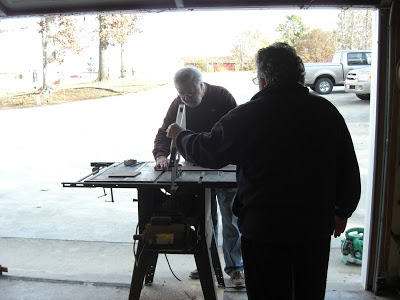 |
| How far we've progressed from the day we cut the maple blanks! |
Today was another great work day for at least two of the Banjo Boys. Monty called earlier in the week and informed me that he planned to spend today with his son Patrick. His priorities are A-OK with the Banjo Boys' Code of Conduct. We love the Waylon Jennings lyrics, "So you do all you can, but then you gotta let go, You're just part of the flow, Of the river that runs, Between fathers and sons." So it was just Clint and I for the day and he arrived around 10:30 AM.
We made a quick run down to the Ace Hardware store to get some denatured alcohol. We had bought some dark tobacco-brown wood stain that has to be diluted with alcohol. We diluted it 10 parts alcohol to 1 part dye. It is very dark and very fast acting. We ran several tests on scrap wood. both maple and walnut. We think we know how we can use this dye to darken our wood and bring out the grain.
When we finished the dye experimentation, we tackled the first band saw cut that will eventually define the overall profile of the neck. After changing band saw blade to a much finer 1/8" blade, we "tuned" the band saw to get all the adjustments correct for the new blade. This took about an hour. Then, we made our cuts:
 |
| The "first cut" in shaping the necks |
In the picture above, I have completed belt sanding of the back surface of the peghead, whereas Clint's is still in the rough cut stage. The dark line on the edge of his peghead is where he intends to put an ebony veneer on the back side of the maple. We got out the thickness sander and looked at ways in which we might be able to make a thin ebony veneer out of some left over ebony that Clint has saved. As part of that effort, we glued a piece of ebony to a pine board that is thick enough to feed through the thickness sander. Next week, we'll try to thin the ebony down to veneer thickness. It should get interesting!
Clint had some remaining pearl and brass inlay to complete his "Milky Way" star pattern, and I had to complete the inlay of my B and U pearl letters, so we worked independently to complete those tasks.
 |
| Current status of the two necks |
The last thing Clint and I did today was to cut off the neck blank at the point where it will join to the turbine ring or "pot" of the banjo. That cut is important because it defines the position at which the bridge must be placed for the predefined string length that our fret spacing was based on. The position of the bridge helps determine the overall sound of the banjo, including its loudness and brightness. The neck cut also determines the angle of the fretboard and the top plane of the banjo body. This angle affects the height of the strings above the last fret, a very important factor in the playability. Our design showed a 1.4 degree angle from the head to the fret surface. But in our case, the turbine ring's outer surface is angled outward at the bottom. Here's the geometry we were hoping to get:
We set the saw blade angle very carefully, measured and marked twice, and made the cut with great trepidation.
The Banjo Boys dined at Sonic today in Hazel Green, Alabama, enjoying the latest Sonic creation, the Ultimate Grilled Bacon Cheddar Cheeseburger. Highly recommended!
BULLETIN -- BULLETIN!!!
In a last-minute dispatch to Banjo Boy Central, Monty let us know that in spite of his absence yesterday, he made significant progress on his own this weekend. Photo evidence shows that he cut out the profile of both his neck and headstock, and drilled the holes into which his mother-of-pearl fret markers will be glued.
 |
| The recesses for the M.O.P. dots |
 |
| Monty's neck and peg head cut out -- WOW! |































Two friends and I have acquired the hard-to-find turbine rings and are building banjos inspired by your Website. We have a few questions:
1. How did you fasten your neck to the turbine ring?
2. How many clamps did you use to pull down on the tensioner ring?
3. Where did you get your head? Did you special order it to a certain diameter? How about the ring that the leather fastens to. Did you buy the head with that ring already in place or did you buy just the leather and separate rings?